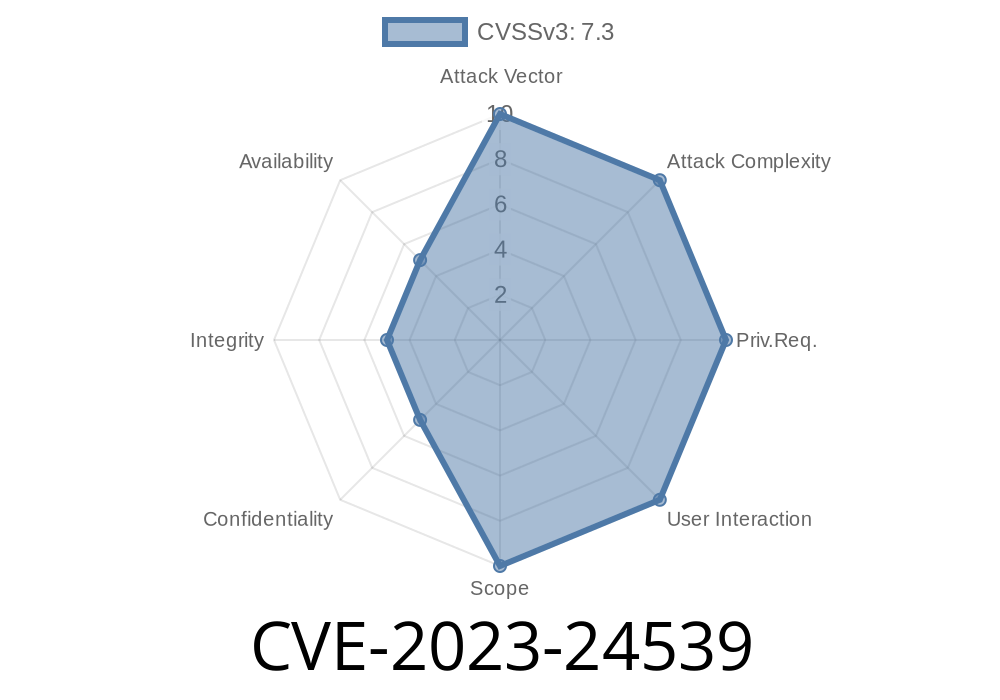In recent days, a new vulnerability has been discovered and assigned as CVE-2023-24539. This vulnerability revolves around the use of angle brackets (<>) in CSS (Cascading Style Sheets) contexts, which are not considered as dangerous characters. However, when these brackets are part of templates containing multiple actions separated by a '/' character, they can unexpectedly close the CSS context and potentially allow for the injection of unintended HTML. In this article, we'll dive into the specifics of this vulnerability, provide code snippets and references, review possible exploit scenarios, and suggest mitigation strategies.
Understanding the Vulnerability
Angle brackets are commonly used in various programming and markup languages, such as XML and HTML. In the context of CSS, angle brackets do not possess any special significance and are often treated as regular characters. The vulnerability in question occurs when these seemingly harmless characters are incorporated into more complex templates containing multiple actions separated by a '/' character.
Here's a simplified example illustrating the issue
<!DOCTYPE html>
<html lang="en">
<head>
<style>
.btn {
background-color: red;
font-size: 16px;
}
.-hack {</style><script>alert('Injected HTML!');</script>}
</style>
</head>
<body>
<button class="btn -hack"></button>
</body>
</html>
As demonstrated in this example, the angle brackets allow for the closure of the CSS context and potentially pave the way for the insertion of a script tag that contains malicious JavaScript code.
Exploit Details
An attacker could potentially exploit this vulnerability by crafting a payload that combines angle brackets with a series of actions separated by a '/' character within a template. This may result in unintentional closure of the CSS style tag and subsequently, the injection of unwanted HTML—possibly even executing a malicious script.
Here's an example payload that an attacker might use
.example {</style><script>alert('Exploited!');</script>}
When this payload is inserted into the vulnerable template, it may prematurely end the style tag and begin executing the injected JavaScript code.
Original References
1. OWASP - Overview of Untrusted Input
2. Mozilla Developer Network - Syntax and Data Types: CSS
3. CWE-79: Improper Neutralization of Input During Web Page Generation ('Cross-site Scripting')
Mitigation Strategies
Users can implement the following strategies to safeguard their applications against this vulnerability:
1. Always validate and sanitize user input to ensure that no angle brackets or other potentially dangerous characters can be inserted.
Use a well-validated CSS parser that properly handles angle brackets in the context of CSS rules.
3. Evaluate third-party libraries and frameworks for their levels of security and resilience against potential exploitation, and utilize those with robust protections.
Conclusion
CVE-2023-24539 highlights the potential risks associated with the usage of angle brackets within CSS contexts. Though the characters themselves may seem benign, their presence can inadvertently facilitate the injection of malicious HTML content. By validating and sanitizing user input, using a secure CSS parsing approach, and evaluating the security of third-party libraries, developers can reduce the likelihood of falling prey to this vulnerability.
Timeline
Published on: 05/11/2023 16:15:00 UTC
Last modified on: 05/22/2023 18:22:00 UTC
